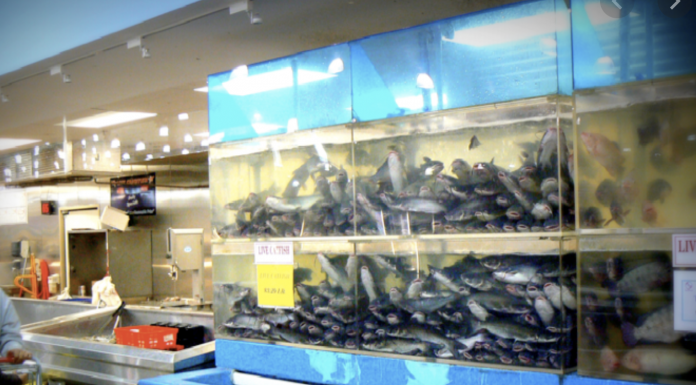They examined four scenarios during their trip from Jan. 14 to Feb. 10:
- direct zoonotic transmission to humans;
- introduction through an intermediate host followed by spillover;
- through the cold food chain;
- or a laboratory incident.
The first one was considered to be a possible to likely pathway; the second was likely to very likely and the latter was extremely unlikely.
Food chain route
When assessing the possibility of introduction through the food chain, experts referred to one outbreak where live virus was isolated from the outer package of an imported frozen product.
“SARS-CoV-2 and related CoVs have been found to persist in conditions such as time, temperature and humidity found during trade of frozen products suggesting the virus could persist on contaminated frozen products.”
However, there is no conclusive evidence for foodborne transmission of SARS-CoV-2 and the probability of cold-chain contamination with the virus is very low:
“While there is some evidence for possible reintroduction of SARS-CoV-2 through handling of imported contaminated frozen products in China since the initial pandemic wave, this would be extraordinary in 2019 where the virus was not widely circulating. Most viruses have been found in 2020 in low concentrations and are not amplified on cold chain products.”
Case control studies of outbreaks in which the cold chain product and food supply is positive would provide support for such items and food as a transmission route, according to the report.
A joint statement from governments including Australia, Canada, Denmark, Japan, Republic of Korea, United Kingdom and the United States expressed concern about the study. They said work on the source of the virus was significantly delayed and lacked access to complete, original data and samples:
“Together, we support a transparent and independent analysis and evaluation, free from interference and undue influence, of the origins of the COVID-19 pandemic. It is critical for independent experts to have full access to all pertinent human, animal, and environmental data, research, and personnel involved in the early stages of the outbreak relevant to determining how this pandemic emerged.”
Further study needed
A spokesperson from the Chinese Ministry of Foreign Affairs said the study of origins is a matter of science:
“To politicize this issue will only severely hinder global cooperation in study of origins, jeopardize anti-pandemic cooperation, and cost more lives. Study of origins is also a global mission that should be conducted in multiple countries and localities. We believe the joint WHO-China study will effectively stimulate global cooperation in origin-tracing.”
Dr. Tedros Adhanom Ghebreyesus, WHO Director-General, said all hypotheses remain on the table with the role of animal markets being unclear:
“The team has confirmed that there was widespread contamination with SARS-CoV-2 in the Huanan market in Wuhan, but could not determine the source of this contamination. Again, I welcome the recommendations for further research, including a full analysis of the trade in animals and products in markets across Wuhan, particularly those linked to early human cases. I concur with the team’s conclusion that farmers, suppliers and their contacts will need to be interviewed.
“The team also addressed the possibility that the virus was introduced to humans through the food chain. Further study will be important to identify what role farmed wild animals may have played in introducing the virus to markets in Wuhan and beyond.”
In the U.S., lawmakers are considering the Preventing Future Pandemics Act. This bipartisan bill wants a shutdown of commercial wildlife markets, to end the import, export and sale of live wildlife for human consumption in the country, and to phase out demand for wildlife as a food source.
(To sign up for a free subscription to Food Safety News, click here.)
Chinese Supermarket Items that Make Us Go ‘What The …?’
5 foods you can find at a Chinese Supermarket that make non-Chinese scratch their heads
by Nancy Ni
CHINOSITY – While other families went to Walmart or Target for their grocery runs, my family always went to the local Chinese supermarket.
I grew up with the bizarre sights and smells of a typical Chinese grocery store. To me, however, all of these items were perfectly normal. It wasn’t until I took my friends to the grocery store did I realize that to a non-Chinese these items are super weird.
1. Live Fish
Yep! To ensure that you are getting the freshest fish, many Chinese grocery stores will carry live fish and butcher them right in front of you. I always thought this was a pretty standard affair until I saw the horror in my friends’ eyes.
2. Dried….???
I never knew what ANY of these things were growing up. Some of these dried things are added to soup, some of them supposedly have medicinal properties. All I know is that a Chinese supermarket isn’t a Chinese supermarket without a section of dried foods.
3. Pig Feet
You know what they say, one man’s trash is another man’s treasure! I personally think pig’s feet are delicious! These are sold along with all your other standard cuts of meat … READ MORE.rint:



